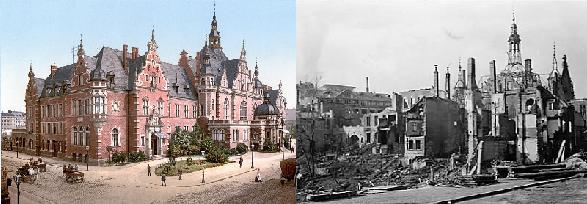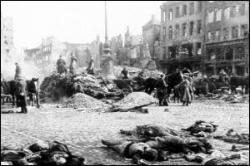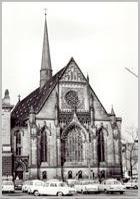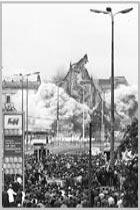





In the worst attack, the RAF opted to use the lethal mix of 50% high explosive and 50% incendiaries. The “bomber stream” of over 500 aircraft menaced the sky, dropping 90,000 staff incendiary bombs and over 1,000 liquid incendiary bombs. 5,000 fires erupted at once, mostly in the city center and the historical old part of town, making it impossible to control. The major roads were made impassable.
The entire historic city center burned. An attack by over 400 US bombers polished off what was left of the city, any surviving cultural facilities as well as hospitals and science enterprises, the esteemed Leipzig university and 78 clinic and hospital buildings, the oldest theatre Schauspielhaus, the famous crystal palace, the municipal library as well as 17 Leipzig school buildings. The entire ancient book center was lost. But it was not over yet. Even though the city was in its last gasps, 820 RAF bombers decided to paw at the dead mouse of a city in another attack. Knowing that refugees from the east had since fled there in panic and fear, the Americans joined in with 2,000 bombers. On February 27, 1945, over 700 American B-17 bombers attacked again, and yet again on April 6th and 8th.
The British then pounced again on the easy prey, on April 10, 1945 with 230 bombers,and on April 11 with 95 bombers. One fifth of the native inhabitants, over 140,000 humans, were homeless and shocked, and along with confused refugees were all ripe for the Soviet domination the Allies had planned. Of 221,178 dwellings, 28,178 were completely destroyed and 93,000 were damaged, thus 20 per cent of the native Leipzig inhabitants had become homeless. Over 4,000 non-residential buildings were destroyed by the last attacks as well, among them fifty six schools, several hospitals, nine churches, several theatres, the art museum, and the main building of the university. The city hall and the historical museums were heavily damaged, the historic houses from the middle ages lost.
More than three quarters of the historic printing district with its printing and publishing houses, bookshops and book and the book museum, were wholly obliterated. The city famous for its book arts lay in ruins. Over 50,000 books and rare manuscripts burned. On April 18, 1945, units of the US army took over and “liberated” the city just long enough to hand it over to the Soviets, horrifying the entrapped local citizens and the refugees who had just fled from the Soviet invasions in the east.
On the north-west the town is bordered by the fine public park and woods of the Rosenthal, and on the west by the Johanna Park and by pleasant groves leading along the banks of the river Pleisse. The old town, with its narrow streets and numerous houses of the 16th and 17th centuries, with their high-pitched roofs, preserves much of its quaint medieval aspect. The market square, lying almost in its centre, is of great interest. Behind the market square and the main street lie a labyrinth of narrow streets inter-connected by covered courtyards and alleys, with extensive warehouses and cellars. The whole, in the time of the great fairs, when every available place is packed with merchandise and thronged with a motley crowd, presents the semblance of an oriental bazaar.
Close to the old Rathaus is Auerbachs Hof, built about 1530 and interesting as being immortalized in Goethe’s Faust. It has a curious old wine vault (Keller) which contains a series of mural paintings of the 16th century, representing the legend on which the play is based.
Leipzig has some interesting monuments; on the market square, statues of Goethe, Leibnitz, Gellert, J. Sebastian Bach, Schumann, Hahnemann, the homeopathist, and Bismarck.The city has a large number of literary, scientific and artistic institutions.
One of the most important is the museum, which contains about 400 modern paintings, a large number of casts, pieces of original sculpture and a well-arranged collection of drawings and engravings. The collection of the historical society and the ethnographical and industrial art collections in Grassi Museum are also of considerable interest. The museum was erected with part of the munificent bequest made to the city by Dominic Grassi in 1831. As a musical centre Leipzig is known all over the world for its excellent conservatorium, founded in 1843. The series of concerts given annually in the Gewandhaus is also of worldwide reputation, and the operatic stage of Leipzig is deservedly ranked among the best (End)
The Construction of the Paulinerkirche, a model of Gothic church architecture, began in 1228 and the church stood for over 700 years with the University of Leipzig. It was extensively renovated in 1900 and contained many historic and artistic artifacts, including a favorite organ of Bach.

|
On May 30, 1968 at 11AM, the church, which had survived the vicious Allied bombings of Leipzig, was destroyed. The Communist leadership of Paul Fröhlich and Walter Ulbricht made the decision on “ideological” grounds leaving only seven days to prepare for the demolition and rescue of artifacts from the church. A weeping crowd of Leipzigers gathered to watch one of their most precious monuments be blown up off of the avenue which had been renamed “Karl Marx Platz.” The rubble was cleared and piled at the edge of the city where it is now covered by a small hill with a small wooden cross which reads, “Paulinerkirche 1968.” |

|